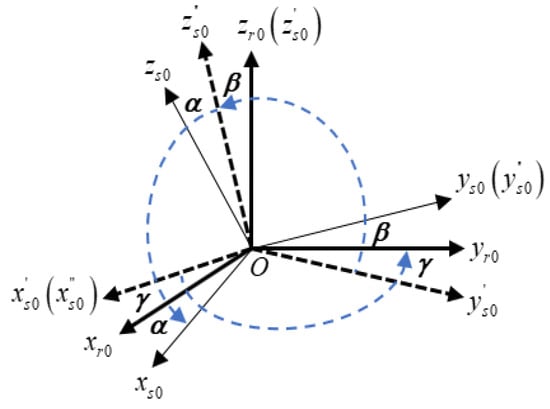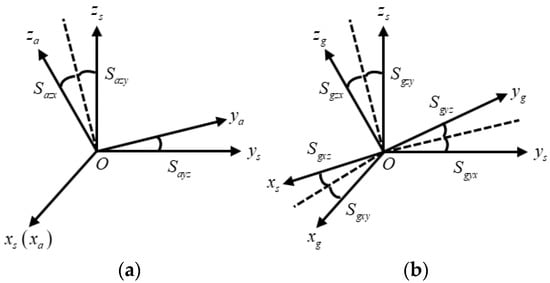Abstract
In order to ensure that dual-axis rotational inertial navigation systems (RINSs) maintain a high level of accuracy over the long term, there is a demand for periodic calibration during their service life. Traditional calibration methods for inertial measurement units (IMUs) involve removing the IMU from the equipment, which is a laborious and time-consuming process. Reinstalling the IMU after calibration may introduce new installation errors. This paper focuses on dual-axis rotational inertial navigation systems and presents a system-level self-calibration method based on invariant errors, enabling high-precision automated calibration without the need for equipment disassembly. First, navigation parameter errors in the inertial frame are expressed as invariant errors. This allows the corresponding error models to estimate initial attitude even more rapidly and accurately in cases of extreme misalignment, eliminating the need for coarse alignment. Next, by utilizing the output of a gimbal mechanism, angular velocity constraint equations are established, and the backtracking navigation is introduced to reuse sensor data, thereby reducing the calibration time. Finally, a rotation scheme for the IMU is designed to ensure that all errors are observable. The observability of the system is analyzed based on a piecewise constant system method and singular value decomposition (SVD) observability analysis. The simulation and experimental results demonstrate that this method can effectively estimate IMU errors and installation errors related to the rotation axis within 12 min, and the estimated error is less than 4%. After using this method to compensate for the calibration error, the velocity and position accuracies of a RINS are significantly improved.
1. Introduction
Inertial navigation systems (INSs) are widely used in various automated unmanned vehicles for their advantages, such as good autonomy and strong concealment []. The precision of inertial navigation parameters directly affects the performance of an INS. In addition to using high-precision inertial devices, rotation modulation techniques can be introduced to improve the accuracy of an INS. The accuracy of rotational inertial navigation systems (RINSs) can be improved several times when using sensors of the same level. RINSs can self-calibrate by rotating their own gimbal mechanism to excite error parameters, which is more convenient and effective for error calibration [,]. Moreover, as the manufacturing cost and volume of inertial devices decrease, RINSs are gradually being applied to various systems and equipment [,,,,].
Inertial measurement units (IMUs) typically require high-precision turntable calibration before leaving the factory. However, the service life of an RINS is generally more than ten years. During this period, IMUs can experience changes in the nominal error parameters due to component aging, the deformation of structural components that support the inertial devices, and other factors [,]. If the original calibration parameters are used over time, it will lead to a decrease in the accuracy of the inertial navigation system, which can have a negative impact on operational efficiency. Therefore, it is necessary to periodically conduct the high-precision autonomous calibration of RINSs to ensure the system’s performance when in use. However, the existing calibration methods take too long to calibrate and cannot quickly self-calibrate.
Currently, calibration methods are divided into discrete calibration and system-level calibration []. The former method involves removing the inertial navigation system, performing calibration using specialized high-precision turntables, and then reinstalling the inertial navigation system. The process is intricate and may introduce new installation errors [,]. The latter method uses navigation errors as observation variables to achieve the optimal estimation of inertial navigation system calibration parameters. This method eliminates the need for specific calibration sites and high-cost equipment. RINSs can be conveniently self-calibrated without an external turntable by exciting error parameters through the rotation of their own gimbal mechanisms. A 30-position calibration scheme was proposed for a dual-axis RINS in reference [], which could calibrate 21 IMU errors by periodically rotating the axis.
Traditional system-level calibration methods for RINSs typically focus on calibrating IMU errors, including zero bias, scale factor errors, and installation errors. Due to the introduction of the gimbal mechanism, the installation errors between the IMU and the rotation axis also need to be accurately calibrated. Reference [] utilized the difference in attitude between the two RINSs to estimate installation errors, but it could not achieve the self-calibration of the RINS. Reference [] proposed a system-level self-calibration method for a dual-axis RINS to address two types of installation errors. However, this method requires the knowledge of an accurate initial attitude.
Currently, the primary method for system-level calibration uses the extended Kalman filter (EKF) to estimate errors [,]. In the traditional EKF framework, state error definitions, such as position and velocity, only consider magnitude differences and ignore directional differences. When the initial misalignment error is significant, it can lead to inconsistencies in the defined error coordinates []. Furthermore, due to the influence of specific force terms in the system matrix, the EKF defined with a linear error state encounters the problem of inconsistent variance estimation. This leads to the filtering estimate of errors that were initially unobservable, causing significant deviations and overly optimistic covariance estimates. To address these issues, the error equation can be projected and transformed to adapt to different application environments. Reference [] eliminated the need for the high-speed integration of specific forces in the calculation of the Kalman filter transformation matrix by transforming the velocity error, which improved the accuracy and stability of the system. Reference [] proposed the state transformation extended Kalman filter (ST-EKF), whereby the specific force vector in the system error model is replaced by the nearly constant gravity vector in a geographical coordinate system, ensuring consistent error state definitions and resolving the variance estimation inconsistency problem. In view of the strong non-linearity and high-dimensional problems of the RINS calibration error equation, the filtering method of sampling the probability space is also widely used in system-level calibration [,].
In recent years, the Lie group and manifold theories have been applied to some inertial-based applications [,]. By representing the states and their errors in double-direct space-isometric groups , new group-based system equations and error equations have been designed []. If the system is a group affine, even when the attitude deviation is significant, the attitude can be obtained through a linear error model []. Based on the existing EKF framework, Barrau used the Lie group theory to construct navigation parameters, establishing a navigation parameter error equation based on invariant errors, and used an invariant extended Kalman filter (IEKF) to unify the initial alignment process, eliminating the need for coarse alignment []. Reference [] studied the characteristics of and the specific mathematical expressions of left-invariant and right-invariant errors under various coordinate frames. The right-invariant EKF projects the gravity vector into the inertial frame and has similar properties to the ST-EKF. The left-invariant EKF eliminates the influence of navigation parameters, and the filter performance does not depend on the selected coordinate system. Reference [] investigated an attitude estimation method using the with consideration of constant drift of the gyro. Therefore, this paper represents navigation parameter errors as invariant errors, transforming a non-linear system into a linear system, thereby improving the accuracy of calibration in cases of large misalignment angles.
To reduce the calibration time and improve calibration accuracy, this paper designs a rotation scheme and utilizes the output of a gimbal mechanism to establish extended measurement equations, rendering all errors observable. Subsequently, the observability of the system is analyzed based on the piecewise constant system (PWCS) observability method and singular value decomposition (SVD) observability analysis. Finally, the paper introduces backtracking navigation [,], enabling the sensor data to be reused to enhance the estimation accuracy within a short period.
The rest of this paper is organized as follows. Section 2 introduces the mathematical foundations for expressing navigation states using . Section 3 presents the IMU error model, gimbal mechanism errors, and the navigation error state model based on , demonstrating that this system is a group affine. Section 4 describes the designed rotation scheme, backtracking scheme, angular velocity constraints (AVCs) during rotation, the establishment of the measurement equations, and the observability analysis of the system. Section 5 validates the proposed method through simulations and experiments. Section 6 provides a summary and outlines future prospects.
2. Mathematical Preliminaries and the Framework of the Proposed Method
In order to apply the Lie group theory [] in RINS system-level self-calibration, this section introduces the mathematical preliminaries of matrix Lie group and Lie algebra to facilitate subsequent error modeling and formula derivation. The matrix Lie group is used to represent the extended pose as [].
where is the special orthogonal group and are the attitude rotation matrix, speed, and position, respectively. The inverse of is provided by
The Lie algebra associated with is provided by
where
The Lie algebra and Lie group can be transformed into each other via exponential mapping and logarithmic mapping as follows:
where
is the rotation vector, denotes the rotation angle, and is the unit-length axis of rotation. denotes the skew-symmetric matrix operation. When is assumed to be small, then , , and .
In addition to the traditional IMU error, this article considers the installation error of the gimbal mechanism and stores the gyro, accelerometer, and gimbal mechanism signals outputs in real time. In order to quickly and accurately estimate the error parameters, the navigation parameters are established in the form of invariant errors, the linear Kalman filter is used to accurately estimate the calibration errors, and the stored data is reused through the backtracking algorithm to shorten the filter convergence time. Finally, a fast, autonomous, and accurate dual-axis rotation inertial navigation system-level self-calibration algorithm is achieved. The structure of the Kalman filter based on the invariant error during self-calibration is shown in Figure 1.
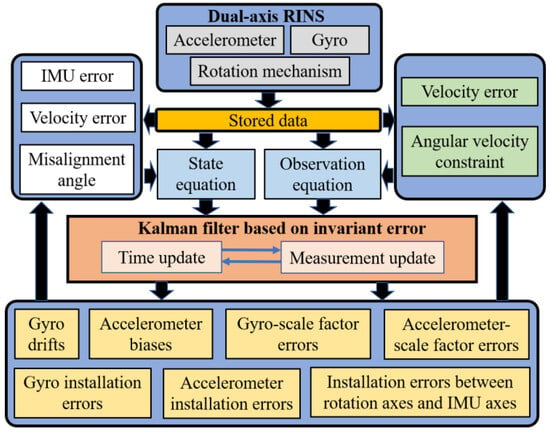
Figure 1.
Schematic diagram of the proposed method in this paper.
4. The Fast Self-Calibration Method and Observability Analysis of the Dual-Axis RINS
4.1. Rotation Scheme Design and Observability Analysis
In order to accurately estimate all the state variables in the self-calibration procedure, the rotation scheme should be properly designed to ensure that all the state variables are observable. Reference [] proposed design principles for a rotation scheme, which included pointing upward and downward alternately for each accelerometer and a bidirectional rotation on each gyro. According to the above principles and the limitations of the gimbal mechanism, the rotation scheme proposed in this article is shown in Figure 4. In a rotation period, first, the outer axis rotates 270 degrees and −270 degrees (corresponding to A and B in Figure 4). Then, the inner axis rotates to −90 degrees (corresponding to C in Figure 4), and the outer axis rotates bidirectionally (corresponding to D and E in Figure 4). Finally, the inner axis rotates bidirectionally (corresponding to F and G in Figure 4) and returns to position A. During the rotation, the angular velocity is , and it stops for seconds after each rotation of 90 degrees. According to Equation (16), except for and , the remaining calibration errors require and to excite. In order to excite the error of the gyros, the gyros should be continuously sensitive to the angular velocity of the gimbal mechanism. In the same way, to excite the error of the accelerometers, the accelerometer should be in the vertical direction of the horizontal plane for a long time. Therefore, in order to fully excite the IMU error, is set to 18°/s and the stop time is set to 30 s. The complete rotation period is 600 s.
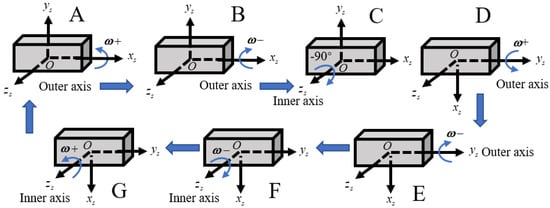
Figure 4.
One period of rotation scheme.
This article uses the PWCS method to verify the feasibility of the designed rotation scheme. In each short time period, the state matrix and measurement matrix are assumed to be constant matrices. At this time, the linear time-varying system transforms into a linear time-invariant system, and the observable matrix of each time period can be obtained. In the i-th time period, the observability matrix of the dynamic system can be expressed as:
where and are the measurement matrix and the state matrix in the i-th time interval and is the dimension of the state. The stripped observability matrix (SOM) is:
When the rank of is n, the system is fully observable, while if the rank of is less than n, the system is not fully observable. Performing a singular value decomposition on , Equation (60) can be obtained:
where and are -dimensional and -dimensional unitary matrices, respectively. , , and are the singular values of .
Define the singular value corresponding to any element of the state vector to be the singular value that maximizes . The observability degree of is defined as:
where , is the measurement in each time period, and its derivatives of each order. is the singular value corresponding to the state component that can be directly obtained from external information.
Corresponding to the left-invariant error model of Equation (57), the rank of the system is 27. is less than the state dimension, indicating that the system is not completely observable. Calculate the observability degrees of each variable at the end of calibration. The observable degrees of , , , , , , , , , , , , , , , , , , , , , , , and are 2.23 × 10−4, 2.25 × 10−4, 1.48 × 10−4, 0.062, 0.063, 0.062, 8.56 × 10−4, 7.51 × 10−5, 2.3 × 10−8, 0.29, 0.33, 0.61, 5.52 × 10−4, 7.71 × 10−6, 6.31 × 10−4, 7.71 × 10−4, 5.78 × 10−4, 5.07 × 10−4, 0.21, 0.26, 0.29, 2.29 × 10−14, 2.29 × 10−14, and 3.64 × 10−16 respectively. The observability degrees of , , and are the worst and is unobservable, which is the reason why the rank of and differ by 3. The system error of the gyros and the installation error angle between the r-frame and the s-frame are poorly observable degrees. In response to this situation, the angular velocity constraint equation is added to the measurement equation to render all the parameters observable.
4.2. Angular Velocity Constraint Equation
During the calibration process, the gimbal mechanism drives the IMU rotation. The angular rate of the gimbal mechanism can be utilized as a reference to calibrate the systematic errors of the gyros and the installation error between the s-frame and the r-frame. The outputs of the gyros in the s-frame can be expressed as follows:
where is the angular velocity of the earth expressed in the in0-frame. is the latitude in the initial location. is the angular velocity of the gimbal mechanism.
By substituting Equations (11) and (12) into Equation (62), the second-order small quantity can be ignored and the IMU measurement constraint equation can be expressed as:
Equation (63) can be converted into the measurement equation of the calibration parameters:
Combine Equations (32), (57) and (64) to obtain the new extended measurement equation:
where .
For the left-invariant error model with and as the system matrix and the measurement matrix, its rank of is 30. The observability degrees of , , , , , , , , , , , , , , , , , , , , , , , and are 0.98, 0.98, 0.98, 2.71 × 10−4, 2.72 × 10−4, 2.71 × 10−4, 0.2, 0.2, 0.2, 2.41 × 10−3, 2.21 × 10−3, 2.36× 10−3, 0.23, 0.21, 0.21, 0.21, 0.22, 0.21, 1.3 × 10−3, 1.1 × 10−3, 8.9 × 10−4, 0.38, 0.35, and 0.23, respectively. The angular velocity constraint equation is added to the measurement equations, which improves the system’s observability, and all calibration parameters can be observed.
From the perspective of the analytical analysis of the variable observability, the accelerometer calibration error has a linear relationship with the first derivative of the velocity error. The gyro error is linearly related to the derivative of the second-order velocity error. It can be seen from the angular velocity constraint equation that there is a linear relationship between the gyros systematic error parameter and . Adding it to the measurement equation can more directly observe the gyro system error and the installation error between the s-frame and r-frame, effectively shortening the calibration time.
4.3. Backtracking Scheme Design in the Inertial Frame
Backtracking navigation reduces the calibration time by utilizing stored data multiple times. The backtracking scheme is shown in Figure 5. During the calibration process, the SINS update algorithm in the inertial frame is applied for forward navigation. During the first forward navigation process, the data of the IMU and gimbal mechanism are stored. Subsequently, using the stored data multiple times, the calibration parameter error can be accurately estimated in a short time.
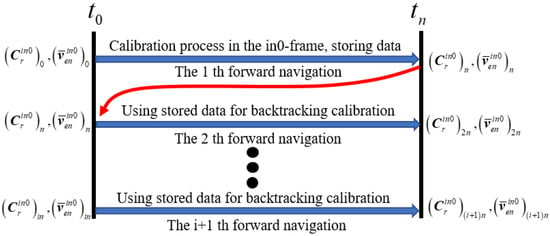
Figure 5.
Backtracking scheme.
5. Simulation Test and Experimental Analysis
This section is devoted to numerically evaluating the calibration performance based on different error state models. The calibration method based on the error state model (30) and measurement model (32) is denoted as RSO-KF. The calibration method based on the error state model (31) and measurement model (32) is denoted as LSO-KF. The calibration method based on the error state model (30) and measurement model (65) is denoted as RSOAVC-KF. The calibration method based on the error state model (31) and measurement model (65) is denoted as LSOAVC-KF. The calibration method based on the error state model (40) and measurement model (66) is denoted as RSEAVC-KF. The calibration method based on the error state model (51) and measurement model (66) is denoted as LSEAVC-KF (the proposed method). The above methods all apply the backtracking method to unify the algorithm process and verify the impact of different error modeling methods on the calibration algorithm. During the simulation and experiment, the dual-axis RINS remained stationary. The location was obtained from a GPS, and the speed was zero.
5.1. Simulation Test
To verify the effectiveness of the proposed algorithm, the simulations are demonstrated in this section. The initial location was 31.94° N, 118.79° E, 15 m. The initial attitude error was 0.1°(roll), 0.1°(pitch), 0.5°(heading). The random gyro drifts were 0.005 deg/h, and the random accelerometer bias was 50 μg. The error of the IMU-scale factor was 100 ppm. The error of the IMU installation angle was 20″. The error of installation angle between the s-frame and r-frame was 200″. The error of the angle of the gimbal mechanism was 0.5″. The error of the angular rate of the gimbal mechanism was 0.7″/s. The rotation scheme is consistent with that described in Section 4.1. The number of backtracking navigations was four.
The simulation was divided into two parts. First, the validity of the angular velocity constraints was verified. Then, the advantages of accuracy were verified and compared with the error modeling method based on .
5.1.1. Verification of the Observability Analysis
The observability was assessed with a covariance analysis. The convergence process of the root mean square (RMS) of the calibration error covariance is shown in Figure 6. It can be seen from Figure 6 that the RMSs of the , , , , and error covariance are large. The observability is consistent with the analysis in Section 4. After introducing AVC constraints into the measurement equation, all the calibration error parameters could be estimated well. Moreover, the RMS of the error covariance became smaller faster.
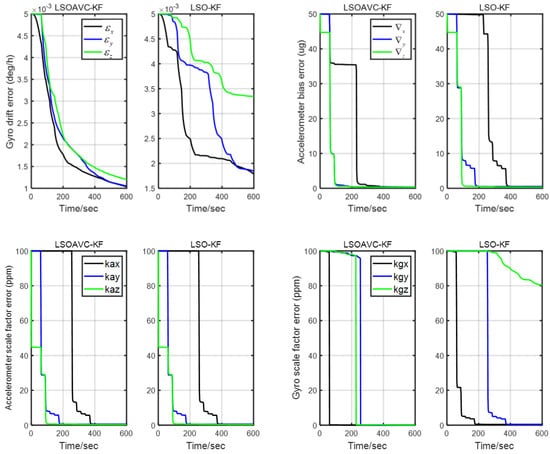
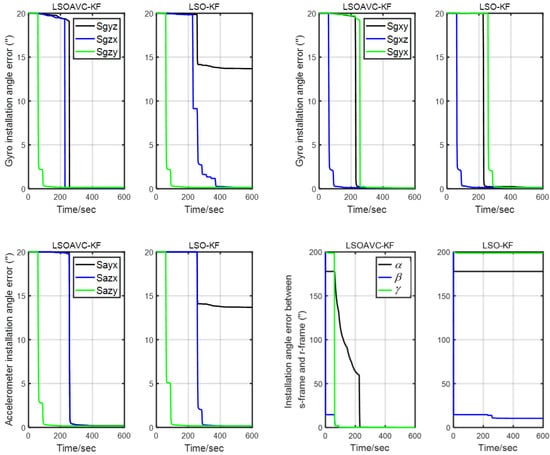
Figure 6.
RMSs of the calibration error covariance.
5.1.2. Comparison of the Calibration Accuracy
In order to eliminate the influence of unobservable installation errors in traditional calibration algorithms, AVC constraints are added as a comparison algorithm to verify the superiority of the calibration algorithm based on invariant error modeling. The four algorithms are evaluated for comparison.
Figure 7, Figure 8, Figure 9 and Figure 10 describe the estimation results of the calibration errors; the red dotted lines represent real values, and the solid lines represent the estimation result of the proposed method (LSEAVC-KF). It took 600 s in the first stage, and then the time spent on backtracking navigation was calculated using the Matlab platform to be 106.1 s. We can see all errors present good convergence with the proposed method within 12 min. Except for the gyro drift error, the rest of the calibration errors converged to near the true value in the first stage. The estimation error of the gyro drift was less than 4%, and the rest of the calibration errors were less than 2%.

Figure 7.
Estimation of IMU bias errors. (a) , , ; (b) , , .

Figure 8.
Estimation of IMU-scale factor errors. (a) , , ; (b) , , .
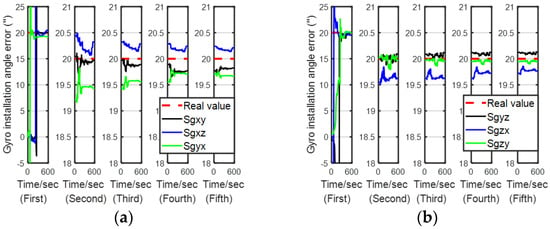
Figure 9.
Estimation of gyro installation angle errors. (a) , , (b) , , .
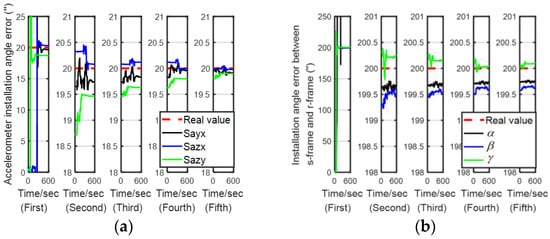
Figure 10.
Estimation of accelerometer installation angle errors. (a) , , ; estimation of installation angle errors between the s-frame and r-frame. (b) , , and .
In order to further verify the superiority of the proposed method, the estimation accuracy of the remaining three methods was compared, and 100 Monte Carlo simulations were performed for the calibration. The statistical results of the mean error (ME) and root mean square error (RMSE) of each error parameter are shown in Table 3. Among the four methods, LSEAVC-KF had the best effect. The error of the invariant error modeling method was significantly smaller than the error of the error modeling method based on , which proves that the invariant error can express the error characteristics more accurately.

Table 3.
Simulation results from the four methods.
In order to prove the calibration performance of LSEAVC-KF in the case of large misalignment angles, the calibration errors under different heading angle errors are shown in Table 4. With an increasing heading angle error, it can be observed that the estimation error experiences a slight growth, but it remains within an acceptable range. The proposed algorithm demonstrates greater applicability and can accurately calibrate errors even in harsh environmental conditions. In comparison to traditional calibration methods, it is less reliant on complex instrumentation and offers a faster convergence rate.

Table 4.
Simulation results of different heading angles.
5.2. Experiment
In order to verify the feasibility of the proposed method in the actual environment, this paper uses a dual-axis SINS to conduct the experiments, as shown in Figure 11. The dual-axis SINS consists of three fiber optic gyroscopes and three quartz accelerometers. The specific performance is shown in Table 5.
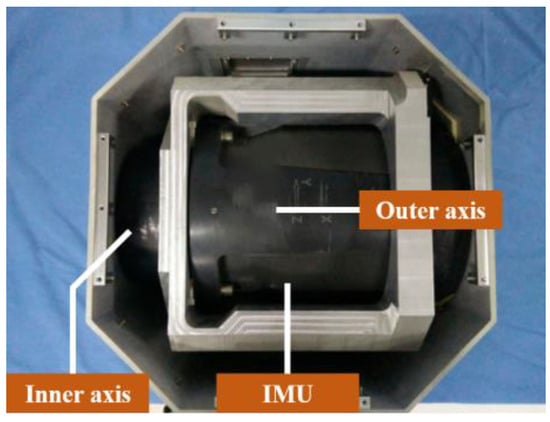
Figure 11.
Internal structure of the dual-axis rotational inertial navigation system (RINS).

Table 5.
Specifications of the dual-axis rotational inertial navigation system.
Since the true error of the IMU cannot be known, the accuracy of the error parameter estimation was verified through navigation performance. The higher the accuracy of the IMU parameter, the better the navigation performance. Hence, a navigation experiment with different calibration results was adopted. LSOAVC-KF was chosen as the traditional algorithm for comparison. The velocity errors and position errors under different calibration results are shown in Figure 12 and Figure 13.
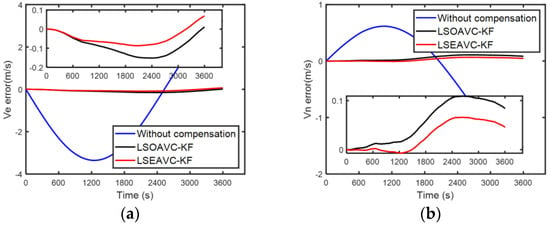
Figure 12.
(a) Velocity errors along east. (b) Velocity errors along north.

Figure 13.
(a) Position errors along east. (b) Position errors along north.
The statistical results of the navigation errors are listed in Table 6. In Table 6, Ve and Vn denote the east and north velocities, respectively, in the navigation frame. Pe and Pn denote the east and north positions, respectively, in the navigation frame. It can be seen in Table 6 and in Figure 12 and Figure 13 that the navigation performance of the inertial navigation system was improved with LSEAVC-KF. The maximum error and root mean square error of LSEAVC-KF are smaller than those of LSOAVC-KF.

Table 6.
Comparison of the velocity and position errors.
Therefore, it can be seen from the simulation and experimental results that the proposed algorithm can quickly and accurately estimate the IMU error and installation error between the r-frame and s-frame within 12 min, effectively improving the navigation performance of a dual-axis rotational inertial navigation system.
6. Conclusions
Inertial navigation systems require rapid and accurate error calibration to ensure their performance. A system-level self-calibration method for a dual-axis rotational inertial navigation system based on invariant errors is proposed. Navigation errors are represented as an element of , allowing the system to converge quickly even during large misalignment angles. Compared to error modeling methods based on , the proposed method is not affected by the calibration environment and does not require a coarse alignment. The method utilizes the information from the gimbal mechanism to establish angular velocity constraint equations, rendering all errors simultaneously estimated. The rotation scheme for the dual-axis rotational inertial navigation system is designed and discussed, and the observability of the system is analyzed using the PWCS method and an SVD-based observability analysis method. A backtracking navigation algorithm is used to shorten the calibration time. Finally, the superiority of the proposed algorithm is verified through simulations and laboratory experiments, demonstrating that the algorithm can rapidly and accurately estimate IMU systematic errors and installation errors between the r-frame and s-frame. Therefore, the proposed calibration algorithm has significant practical value and can significantly improve navigation accuracy.
Author Contributions
Conceptualization, X.S. and P.L.; methodology, X.S.; software, X.S.; validation, X.S. and W.G.; formal analysis, X.S. and R.L.; investigation, X.S.; resources, X.S. and J.L.; data curation, X.S.; writing—original draft preparation, X.S.; writing—review and editing, X.S.; visualization, X.S.; supervision, J.L.; project administration, J.L.; funding acquisition, J.L. All authors have read and agreed to the published version of the manuscript.
Funding
This work is sponsored by the National Key Research and Development Program (2022YFB3904300), Key Program of the National Natural Science Foundation of China (U2233215), National Natural Science Youth Foundation of China (62203216), and Natural Science Youth Foundation of the Jiangsu Province (BK20220886).
Institutional Review Board Statement
Not applicable.
Informed Consent Statement
Not applicable.
Data Availability Statement
The data that support the findings of this study are available from the corresponding author upon reasonable request.
Conflicts of Interest
The authors declare no conflicts of interest.
References
- Groves, P.D. Principles of GNSS, inertial, and multisensor integrated navigation systems, [Book review]. IEEE Aerosp. Electron. Syst. Mag. 2015, 30, 26–27. [Google Scholar] [CrossRef]
- Wang, B.; Ren, Q.; Deng, Z.; Fu, M. A self-calibration method for nonorthogonal angles between gimbals of rotational inertial navigation system. IEEE Trans. Ind. Electron. 2014, 62, 2353–2362. [Google Scholar] [CrossRef]
- Ren, Q.; Wang, B.; Deng, Z.; Fu, M. A multi-position self-calibration method for dual-axis rotational inertial navigation system. Sens. Actuators A Phys. 2014, 219, 24–31. [Google Scholar] [CrossRef]
- Zhang, Q.; Wang, L.; Liu, Z.; Zhang, Y. Innovative self-calibration method for accelerometer scale factor of the missile-borne RINS with fiber optic gyro. Opt. Express 2016, 24, 21228–21243. [Google Scholar] [CrossRef] [PubMed]
- Wei, Q.; Zha, F.; Chang, L. Novel rotation scheme for dual-axis rotational inertial navigation system based on body diagonal rotation of inertial measurement unit. Meas. Sci. Technol. 2022, 33, 095105. [Google Scholar] [CrossRef]
- Li, Q.; Li, K.; Liang, W. A Dual-Axis Rotation Scheme for Long-Endurance Inertial Navigation Systems. IEEE Trans. Instrum. Meas. 2022, 71, 1–10. [Google Scholar] [CrossRef]
- Ishibashi, S.; Tsukioka, S.; Yoshida, H.; Hyakudome, T.; Sawa, T.; Tahara, J.; Aoki, T.; Ishikawa, A. Accuracy Improvement of an Inertial Navigation System brought about by the Rotational Motion. In Proceedings of the OCEANS 2007—Europe, Aberdeen, Scotland, 18–21 June 2007; pp. 1–5. [Google Scholar]
- Gao, J.; Li, K.; Chen, Y. Study on Integration of FOG Single-Axis Rotational INS and Odometer for Land Vehicle. IEEE Sens. J. 2018, 18, 752–763. [Google Scholar] [CrossRef]
- Zhang, Q.; Niu, X.; Shi, C. Impact Assessment of Various IMU Error Sources on the Relative Accuracy of the GNSS/INS Systems. IEEE Sens. J. 2020, 20, 5026–5038. [Google Scholar] [CrossRef]
- Zhang, H.; Zheng, W.; Tang, G. Stellar/inertial integrated guidance for responsive launch vehicles. Aerosp. Sci. Technol. 2012, 18, 35–41. [Google Scholar] [CrossRef]
- Bo, X.; Feng, S. A FOG Online Calibration Research Based on High-precision three-axis Turntable. In Proceedings of the 2009 International Asia Conference on Informatics in Control, Automation and Robotics, Bangkok, Thailand, 1–2 February 2009; pp. 454–458. [Google Scholar]
- Zheng, Z.; Han, S.; Zheng, K. An eight-position self-calibration method for a dual-axis rotational Inertial Navigation System. Sens. Actuators A-Phys. 2015, 232, 39–48. [Google Scholar] [CrossRef]
- Sun, F.; Xia, J.; Ben, Y.; Zhang, X.; IEEE. Four-position Drift Measurement of SINS Based on Single-axis Rotation. In Proceedings of the 2012 IEEE/ION Position, Location and Navigation Symposium (PLANS), Myrtle Beach, SC, USA, 23–26 April 2012; pp. 818–823. [Google Scholar]
- Wei, Q.; Zha, F.; He, H.; Li, B. An Improved System-Level Calibration Scheme for Rotational Inertial Navigation Systems. Sensors 2022, 22, 7610. [Google Scholar] [CrossRef]
- Hu, P.; Xu, P.; Chen, B.; Wu, Q. A Self-Calibration Method for the Installation Errors of Rotation Axes Based on the Asynchronous Rotation of Rotational Inertial Navigation Systems. IEEE Trans. Ind. Electron. 2018, 65, 3550–3558. [Google Scholar] [CrossRef]
- Bai, S.; Lai, J.; Lyu, P.; Xu, X.; Liu, M.; Huang, K. A System-Level Self-Calibration Method for Installation Errors in A Dual-Axis Rotational Inertial Navigation System. Sensors 2019, 19, 4005. [Google Scholar] [CrossRef]
- Huang, Z.; Du, P.; Kosterev, D.; Yang, B. Application of extended Kalman filter techniques for dynamic model parameter calibration. In Proceedings of the 2009 IEEE Power & Energy Society General Meeting, Calgary, AB, Canada, 26–30 July 2009; pp. 1–8. [Google Scholar] [CrossRef]
- Chen, D.; Yuan, P.; Wang, T.; Cai, Y.; Tang, H. A normal sensor calibration method based on an extended Kalman filter for robotic drilling. Sensors 2018, 18, 3485. [Google Scholar] [CrossRef]
- Li, K.; Chang, L.; Chen, Y. Common Frame Based Unscented Quaternion Estimator for Inertial-Integrated Navigation. IEEE ASME Trans. Mechatron. 2018, 23, 2413–2423. [Google Scholar] [CrossRef]
- Scherzinger, B.M.; Reid, D.B. Modified strapdown inertial navigator error models. In Proceedings of the 1994 IEEE Position, Location and Navigation Symposium (PLANS’94), Las Vegas, NV, USA, 11–15 April 1994; pp. 426–430. [Google Scholar] [CrossRef]
- Wang, M.; Wu, W.; Zhou, P.; He, X. State transformation extended Kalman filter for GPS/SINS tightly coupled integration. GPS Solut. 2018, 22, 112. [Google Scholar] [CrossRef]
- He, H.; Tang, H.; Xu, J.; Liang, Y.; Li, F. A SINS/USBL System-Level Installation Parameter Calibration With Improved RDPSO. IEEE Sens. J. 2023, 23, 17214–17223. [Google Scholar] [CrossRef]
- Cheng, J.; Liu, P.; Wei, Z.; Luo, G. A novel MEMS-RIMU self-calibration method based on gravity vector observation. Meas. Sci. Technol. 2021, 32, 055108. [Google Scholar] [CrossRef]
- Zhang, T.; Wu, K.; Song, J.; Huang, S.; Dissanayake, G. Convergence and Consistency Analysis for a 3-D Invariant-EKF SLAM. IEEE Robot. Autom. Lett. 2017, 2, 733–740. [Google Scholar] [CrossRef]
- Potokar, E.; Norman, K.; Mangelson, J. Invariant Extended Kalman Filtering for Underwater Navigation. IEEE Robot. Autom. Lett. 2021, 6, 5792–5799. [Google Scholar] [CrossRef]
- Barrau, A.; Bonnabel, S. The Invariant Extended Kalman Filter as a Stable Observer. IEEE Trans. Autom. Control. 2017, 62, 1797–1812. [Google Scholar] [CrossRef]
- Chang, L.; Qin, F.; Xu, J. Strapdown Inertial Navigation System Initial Alignment Based on Group of Double Direct Spatial Isometries. IEEE Sens. J. 2022, 22, 803–818. [Google Scholar] [CrossRef]
- Barrau, A.; Bonnabel, S. Invariant kalman filtering. Annu. Rev. Control Robot. Auton. Syst. 2018, 1, 237–257. [Google Scholar] [CrossRef]
- Luo, Y.; Guo, C.; You, S.; Hu, J.; Liu, J. SE2 (3) based Extended Kalman Filter and Smoothing for Inertial-Integrated Navigation. arXiv 2021, arXiv:2102.12897. [Google Scholar]
- Chang, L.B. SE(3) based extended Kalman filter for attitude estimation. J. Chin. Inert. Technol. 2020, 28, 499–504, 550. [Google Scholar]
- Wang, J.; Chen, X.; Shao, X. An Adaptive Multiple Backtracking UKF Method Based on Krein Space Theory for Marine Vehicles Alignment Process. IEEE Trans. Veh. Technol. 2023, 72, 3214–3226. [Google Scholar] [CrossRef]
- Lin, Y.; Miao, L.; Zhou, Z. A high-accuracy initial alignment method based on backtracking process for strapdown inertial navigation system. Measurement 2022, 201, 111712. [Google Scholar] [CrossRef]
- Sola, J.; Deray, J.; Atchuthan, D. A micro Lie theory for state estimation in robotics. arXiv 2018, arXiv:1812.01537. [Google Scholar]
- Tang, H.; Xu, J.; Chang, L.; Shi, W.; He, H. Invariant Error-Based Integrated Solution for SINS/DVL in Earth Frame: Extension and Comparison. IEEE Trans. Instrum. Meas. 2023, 72, 1–17. [Google Scholar] [CrossRef]
- Gao, P.; Li, K.; Wang, L.; Liu, Z. A Self-Calibration Method for Accelerometer Nonlinearity Errors in Triaxis Rotational Inertial Navigation System. IEEE Trans. Instrum. Meas. 2017, 66, 243–253. [Google Scholar] [CrossRef]
Disclaimer/Publisher’s Note: The statements, opinions and data contained in all publications are solely those of the individual author(s) and contributor(s) and not of MDPI and/or the editor(s). MDPI and/or the editor(s) disclaim responsibility for any injury to people or property resulting from any ideas, methods, instructions or products referred to in the content. |
© 2024 by the authors. Licensee MDPI, Basel, Switzerland. This article is an open access article distributed under the terms and conditions of the Creative Commons Attribution (CC BY) license (https://creativecommons.org/licenses/by/4.0/).
